The high-vacuum fiber feedthrough flanges market is projected to expand from USD 68.8 million in 2025 to USD 106.8 million by 2035, with an approximate year-over-year growth rate of 4.3% to 4.8% across the forecast horizon. The early phase (2025–2027) shows steady incremental gains as semiconductor and instrumentation manufacturers continue replacing legacy sealing interfaces with fiber-compatible vacuum components. Growth during this period is primarily driven by standard flange demand in laboratory vacuum systems, optical diagnostic chambers, and compact analytical instruments, generating predictable year-on-year value additions aligned with equipment manufacturing cycles.
Between 2028 and 2030, YoY growth accelerates moderately as fiber optic integration in vacuum environments transitions from specialized research applications to mainstream industrial production workflows, especially in optical sensing and plasma processing equipment. This phase contributes 44.4% of total decade growth, with yearly market expansion supported by the adoption of standard type feedthroughs featuring improved leak-tight sealing performance and thermal stability under repeated vacuum cycling. The latter half of the decade (2031–2035) demonstrates more robust YoY increases, driven by semiconductor process equipment upgrades, aerospace optical communication payload development, and medical laser system manufacturing, where precision alignment and contamination-free optical transmission become critical performance parameters, leading to expanded feedthrough utilization across advanced vacuum infrastructure deployments.
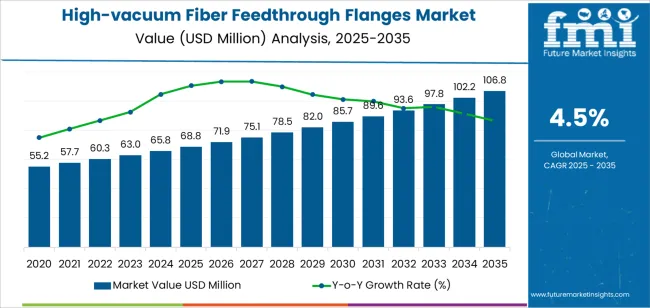
The latter half (2030-2035) will witness sustained growth from USD 85.7 million to USD 106.8 million, representing an addition of USD 21.1 million or 55.6% of the decade's expansion. This period will be defined by mass market penetration of specialized feedthrough designs, integration with comprehensive vacuum system platforms, and seamless compatibility with existing instrumentation infrastructure. The market trajectory signals fundamental shifts in how manufacturers approach vacuum sealing optimization and fiber integration quality management, with participants positioned to benefit from sustained demand across multiple product types and application segments.
The High-vacuum Fiber Feedthrough Flanges market demonstrates distinct growth phases with varying market characteristics and competitive dynamics. Between 2025 and 2030, the market progresses through its technology adoption phase, expanding from USD 68.8 million to USD 85.7 million with steady annual increments averaging 4.5% growth. This period showcases the transition from basic feedthrough formulations to advanced standard type systems with enhanced vacuum sealing capabilities and integrated fiber protection systems becoming mainstream features.
The 2025-2030 phase adds USD 16.9 million to market value, representing 44.4% of total decade expansion. Market maturation factors include standardization of vacuum instrumentation and fiber optic protocols, declining component costs for specialized feedthrough formulations, and increasing industry awareness of reliable sealing benefits reaching optimal vacuum integrity effectiveness in semiconductor and medical equipment applications. Competitive landscape evolution during this period features established manufacturers like Thorlabs and OEfind expanding their feedthrough portfolios while specialty manufacturers focus on advanced sealing development and enhanced vacuum capabilities.
From 2030 to 2035, market dynamics shift toward advanced integration and global manufacturing expansion, with growth continuing from USD 85.7 million to USD 106.8 million, adding USD 21.1 million or 55.6% of total expansion. This phase transition centers on specialized product type systems, integration with automated vacuum networks, and deployment across diverse semiconductor and aerospace scenarios, becoming standard rather than specialized applications. The competitive environment matures with focus shifting from basic sealing capability to comprehensive vacuum optimization systems and integration with instrumentation monitoring platforms.
| Metric | Value |
|---|---|
| Market Value (2025) | USD 68.8 million |
| Market Forecast (2035) | USD 106.8 million |
| Growth Rate | 4.5% CAGR |
| Leading Technology | Standard Type Product Type |
| Primary Application | Medical Equipment Application Segment |
The market demonstrates strong fundamentals with standard type systems capturing a dominant share through advanced vacuum sealing and fiber integration optimization capabilities. Medical equipment applications drive primary demand, supported by increasing precision instrumentation and specialized vacuum technology requirements. Geographic expansion remains concentrated in developed markets with established semiconductor manufacturing infrastructure, while emerging economies show accelerating adoption rates driven by electronics production expansion and rising technological standards.
Market expansion rests on three fundamental shifts driving adoption across the medical equipment, semiconductor, and aerospace sectors. First, vacuum instrumentation demand creates compelling operational advantages through high-vacuum fiber feedthrough flanges that provide immediate signal transmission and hermetic sealing without compromising vacuum integrity, enabling manufacturers to meet stringent quality standards while maintaining production productivity and reducing contamination risks. Second, semiconductor manufacturing modernization accelerates as electronics producers worldwide seek advanced feedthrough systems that complement traditional vacuum processes, enabling precise fiber integration and quality control that align with industry standards and cleanliness requirements.
Third, precision instrumentation enhancement drives adoption from medical equipment manufacturers and aerospace facilities requiring effective sealing solutions that maximize signal integrity while maintaining operational reliability during vacuum operations and measurement applications. However, growth faces headwinds from component cost challenges that vary across feedthrough suppliers regarding the pricing of advanced vacuum systems and specialty materials, which may limit adoption in cost-sensitive environments. Technical limitations also persist regarding pressure differential requirements and thermal expansion concerns that may reduce effectiveness in extreme vacuum conditions and temperature cycling scenarios, which affect sealing performance and operational requirements.
The high-vacuum fiber feedthrough flanges market represents a specialized yet critical vacuum technology opportunity driven by expanding global semiconductor production, medical instrumentation modernization, and the need for superior hermetic sealing in diverse vacuum applications. As manufacturers worldwide seek to achieve optimal vacuum integrity, reduce signal loss, and integrate advanced feedthrough systems with automated platforms, high-vacuum fiber feedthrough flanges are evolving from basic sealing components to sophisticated integration solutions ensuring operational reliability and vacuum excellence leadership.
The market's growth trajectory from USD 68.8 million in 2025 to USD 106.8 million by 2035 at a 4.5% CAGR reflects fundamental shifts in vacuum technology requirements and instrumentation optimization. Geographic expansion opportunities are particularly pronounced in Asia Pacific markets, while the dominance of standard type systems and medical equipment applications provides clear strategic focus areas.
Strengthening the dominant standard type segment through enhanced vacuum sealing, superior fiber protection, and automated integration systems. This pathway focuses on optimizing hermetic performance, improving signal transmission, extending operational effectiveness to optimal vacuum rates, and developing specialized formulations for diverse applications. Market leadership consolidation through advanced sealing engineering and automated production integration enables premium positioning while defending competitive advantages against alternative technologies. Expected revenue pool: USD 12-16 million
Rapid semiconductor manufacturing and medical equipment growth across Asia Pacific creates substantial expansion opportunities through local production capabilities and technology transfer partnerships. Growing electronics investment and government technology initiatives drive sustained demand for advanced feedthrough systems. Localization strategies reduce import costs, enable faster technical support, and position companies advantageously for procurement programs while accessing growing domestic markets. Expected revenue pool: USD 10-14 million
Expansion within the dominant medical equipment segment (estimated 45% market share) through specialized feedthrough designs addressing precision instrumentation standards and high-reliability requirements. This pathway encompasses diagnostic equipment systems, analytical instrument integration, and compatibility with diverse medical device processes. Premium positioning reflects superior vacuum integrity and comprehensive regulatory compliance supporting modern medical equipment production. Expected revenue pool: USD 8.5-11.5 million
Strategic expansion into semiconductor applications (estimated 35% market share) requires enhanced vacuum capabilities and specialized feedthrough formulations addressing manufacturing operational requirements. This pathway addresses process equipment integration, contamination control, and ultra-high vacuum designs with advanced sealing engineering for demanding semiconductor standards. Premium pricing reflects specialized application requirements and extended reliability standards. Expected revenue pool: USD 7-9.5 million
Development of specialized feedthrough formulations for aerospace applications (estimated 15% share) and other segments (5%), addressing specific vacuum requirements and niche instrumentation demands. This pathway encompasses satellite systems, space instrumentation, and cost-effective alternatives for emerging technology segments. Technology differentiation through proprietary sealing designs enables diversified revenue streams while reducing dependency on single application platforms. Expected revenue pool: USD 6-8 million
Expansion of customized type segment (estimated 40% market share) through enhanced application-specific designs, premium sealing accuracy, and specialized vacuum requirements. This pathway encompasses unique instrumentation applications, proprietary equipment integration, and specialty formulations requiring superior engineering characteristics. Market development through advanced custom engineering enables differentiated positioning while accessing premium markets requiring highest-precision sealing solutions. Expected revenue pool: USD 5-7 million
Development of certified feedthrough formulations addressing regulatory compliance and quality standards across medical equipment and semiconductor applications. This pathway encompasses ISO certification, cleanroom compatibility, and comprehensive quality documentation. Premium positioning reflects regulatory leadership and quality assurance expertise while enabling access to regulated procurement programs and compliance-driven manufacturing partnerships. Expected revenue pool: USD 4-5.5 million
Primary Classification: The market segments by product type into Standard Type and Customized Type categories, representing the evolution from basic feedthrough components to specialized sealing solutions for comprehensive vacuum optimization.
Secondary Classification: Application segmentation divides the market into Medical Equipment, Semiconductors, Aerospace, and Others sectors, reflecting distinct requirements for vacuum integrity, sealing reliability, and fiber transmission standards.
Regional Classification: Geographic distribution covers Asia Pacific, Europe, North America, and other regions, with developed markets leading adoption while emerging economies show accelerating growth patterns driven by semiconductor manufacturing expansion programs.
The segmentation structure reveals technology progression from standard feedthrough-based formulations toward specialized sealing systems with enhanced vacuum and reliability capabilities, while application diversity spans from medical equipment to specialized semiconductor and aerospace applications requiring precise feedthrough solutions.

Market Position: Standard type systems command the leading position in the High-vacuum Fiber Feedthrough Flanges market with approximately 60% market share through advanced sealing technology, including superior vacuum integrity, proven reliability capability, and integration optimization that enable manufacturers to achieve optimal performance across diverse medical equipment and semiconductor environments.
Value Drivers: The segment benefits from manufacturer preference for reliable feedthrough systems that provide consistent vacuum sealing, reduced installation complexity, and operational efficiency without requiring significant customization modifications. Advanced sealing features enable standardized mounting, leak-tight performance, and integration with existing vacuum equipment, where sealing reliability and cost-effectiveness represent critical operational requirements.
Competitive Advantages: Standard type systems differentiate through proven vacuum performance, consistent sealing quality, and integration with automated production systems that enhance operational effectiveness while maintaining optimal integrity suitable for diverse instrumentation applications.
Key market characteristics:
Customized type systems maintain specialized sealing positioning in the High-vacuum Fiber Feedthrough Flanges market due to their application-specific properties and unique integration advantages. These systems appeal to manufacturers requiring sophisticated design capabilities with superior customization for specialized vacuum applications. Market adoption is driven by aerospace equipment expansion, emphasizing high-precision sealing solutions and engineering excellence through optimized custom designs while maintaining comprehensive vacuum capabilities.

Market Context: Medical equipment applications dominate the High-vacuum Fiber Feedthrough Flanges market with approximately 45% market share due to widespread adoption of precision instrumentation and increasing focus on vacuum integrity, signal quality, and quality management applications that minimize contamination risks while maintaining medical device standards.
Appeal Factors: Medical equipment manufacturers prioritize sealing reliability, vacuum consistency, and integration with existing instrumentation infrastructure that enables coordinated feedthrough deployment across multiple analytical systems. The segment benefits from substantial healthcare investment and modernization programs that emphasize the acquisition of feedthrough flanges for quality control and measurement accuracy applications.
Growth Drivers: Medical equipment production programs incorporate high-vacuum fiber feedthrough flanges as standard components for diagnostic operations, while analytical instrument growth increases demand for hermetic sealing capabilities that comply with regulatory standards and minimize signal interference.
Market Challenges: Varying medical device standards and equipment configuration differences may limit feedthrough standardization across different manufacturing facilities or operational scenarios.
Application dynamics include:
Semiconductor applications capture approximately 35% market share through specialized vacuum requirements in process equipment operations, fabrication facility production, and cleanroom instrumentation applications. These facilities demand robust feedthrough systems capable of maintaining ultra-high vacuum while providing reliable fiber transmission and contamination-free operational capabilities.
Aerospace applications account for approximately 15% market share, while other segments capture 5%, including research instrumentation, industrial vacuum systems, and specialty scientific applications requiring feedthrough capabilities for vacuum optimization and signal transmission compliance.
Growth Accelerators: Semiconductor manufacturing expansion drives primary adoption as high-vacuum fiber feedthrough flanges provide superior vacuum sealing capabilities that enable production facilities to meet stringent contamination standards without excessive component costs, supporting fabrication operations and cleanroom missions that require precise fiber integration applications. Vacuum instrumentation infrastructure demand accelerates market expansion as equipment manufacturers seek effective sealing systems that minimize leak paths while maintaining operational effectiveness during vacuum processing and analytical measurement scenarios. Technology sector investment increases worldwide, creating sustained demand for advanced feedthrough systems that complement traditional vacuum processes and provide operational reliability in competitive markets.
Growth Inhibitors: Component cost challenges vary across feedthrough suppliers regarding the pricing of advanced vacuum systems and specialty sealing materials, which may limit operational flexibility and market penetration in regions with constrained equipment budgets or cost-sensitive manufacturing operations. Technical performance limitations persist regarding thermal cycling requirements and pressure differential concerns that may reduce effectiveness in extreme vacuum environments, cryogenic applications, or facilities with demanding operational cycles, affecting sealing reliability and vacuum requirements. Market fragmentation across multiple industry standards and vacuum system configurations creates compatibility concerns between different feedthrough suppliers and existing instrumentation infrastructure.
Market Evolution Patterns: Adoption accelerates in semiconductor fabrication and medical instrumentation sectors where vacuum integrity justifies feedthrough investment costs, with geographic concentration in developed markets transitioning toward mainstream adoption in emerging economies driven by electronics manufacturing expansion and technology awareness. Technology development focuses on enhanced sealing materials, improved thermal management, and compatibility with automated vacuum systems that optimize hermetic performance and operational effectiveness. The market could face disruption if alternative sealing technologies or wireless transmission innovations significantly limit the deployment of fiber feedthrough flanges in vacuum applications, though feedthrough flanges' unique combination of hermetic sealing, signal transmission, and vacuum compatibility continues to make them preferred in precision instrumentation applications.
The High-vacuum Fiber Feedthrough Flanges market demonstrates varied regional dynamics with Growth Leaders including China (6% CAGR) and India (5.6% CAGR) driving expansion through semiconductor manufacturing capacity additions and technology infrastructure programs. Steady Performers encompass Germany (5.1% CAGR), Brazil (4.7% CAGR), and United States (4.2% CAGR), benefiting from established electronics industries and advanced instrumentation adoption. Mature Markets feature United Kingdom (3.8% CAGR) and Japan (3.3% CAGR), where specialized precision equipment applications and quality vacuum integration support consistent growth patterns.
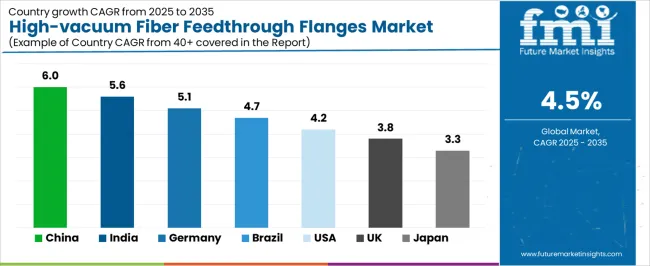
| Country | CAGR (2025-2035) |
|---|---|
| China | 6% |
| India | 5.6% |
| Germany | 5.1% |
| Brazil | 4.7% |
| United States | 4.2% |
| United Kingdom | 3.8% |
| Japan | 3.3% |
Regional synthesis reveals Asia Pacific markets leading adoption through semiconductor manufacturing expansion and vacuum technology infrastructure development, while European countries maintain steady expansion supported by precision instrumentation advancement and quality standardization requirements. North American markets show moderate growth driven by medical equipment applications and vacuum integration trends.
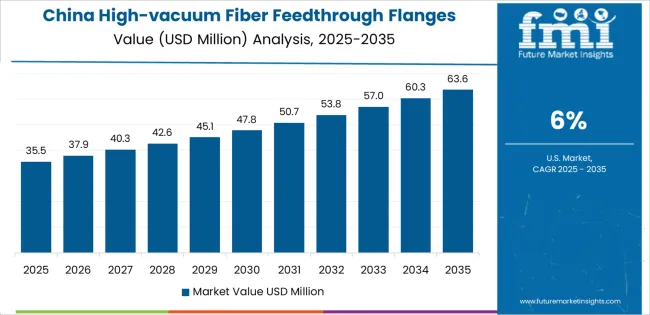
The Chinese market emphasizes advanced vacuum features, including precision sealing control and integration with comprehensive instrumentation platforms that manage vacuum quality, fiber transmission optimization, and sealing applications through unified monitoring systems. The country demonstrates strong growth at 6% CAGR, driven by semiconductor manufacturing expansion, technology infrastructure initiatives, and emerging electronics industry development that support feedthrough flange integration. Chinese manufacturing operations prioritize operational effectiveness with high-vacuum fiber feedthrough flanges delivering consistent sealing performance through advanced vacuum capabilities and system adaptation features.
Technology deployment channels include major semiconductor fabricators, specialized vacuum equipment distributors, and electronics procurement programs that support professional applications for complex vacuum sealing and fiber integration applications. Instrumentation platform integration capabilities with established manufacturing systems expand market appeal across diverse operational requirements seeking vacuum integrity and transmission benefits. The expanding semiconductor base and accelerating electronics market create sustained demand, while innovative applications in medical devices and aerospace systems open new growth avenues.
Performance Metrics:
Germany's advanced manufacturing market demonstrates sophisticated feedthrough flange deployment with documented operational effectiveness in medical equipment applications and semiconductor facilities through integration with existing vacuum systems and instrumentation infrastructure. The country leverages engineering expertise in precision technology and vacuum systems integration to maintain strong growth at 5.1% CAGR. Industrial centers, including Munich, Dresden, and Berlin, showcase premium installations where feedthrough flange systems integrate with comprehensive vacuum platforms and quality management systems to optimize instrumentation operations and sealing effectiveness.
German manufacturing operations prioritize system reliability and quality compliance in feedthrough development, creating demand for certified vacuum systems with advanced features, including hermetic sealing verification and leak detection integration. The market benefits from established precision instrumentation infrastructure and commitment to invest in advanced vacuum technologies that provide long-term operational benefits and compliance with EU quality and safety standards.
Market Intelligence Brief:
The USA high-vacuum fiber feedthrough flanges market demonstrates sophisticated deployment across medical equipment applications with documented effectiveness in analytical instrumentation and semiconductor facilities through integration with comprehensive vacuum management systems and quality infrastructure. The country leverages advanced technology capabilities in precision engineering and vacuum optimization technologies to maintain moderate growth at 4.2% CAGR. Technology centers, including California, Massachusetts, and Texas, showcase premium installations where feedthrough flange systems integrate with comprehensive instrumentation platforms and automated vacuum networks to optimize sealing accuracy and transmission effectiveness.
American manufacturing operations prioritize vacuum reliability and quality compliance in feedthrough development, creating demand for certified systems with advanced features, including automated leak testing and signal integrity monitoring. The market benefits from established medical device infrastructure and willingness to invest in advanced vacuum technologies that provide long-term operational benefits and compliance with FDA and industry quality standards.
Market Intelligence Brief:
The UK high-vacuum fiber feedthrough flanges market demonstrates advanced quality deployment with documented operational effectiveness in medical equipment applications and research facilities through integration with existing vacuum systems and instrumentation infrastructure. The country leverages technology expertise in precision engineering and vacuum systems integration to maintain steady growth at 3.8% CAGR. Technology centers, including Cambridge, Oxford, and Manchester, showcase quality installations where feedthrough flange systems integrate with comprehensive vacuum platforms and quality management systems to optimize instrumentation compliance and sealing effectiveness.
British manufacturing operations prioritize system reliability and regulatory compliance in feedthrough development, creating demand for certified vacuum systems with advanced features, including automated quality monitoring and performance verification. The market benefits from established research instrumentation infrastructure and commitment to invest in quality vacuum technologies that provide long-term operational benefits and compliance with UK and EU quality standards. Medical equipment applications, research instrumentation systems, and analytical equipment programs drive diversified demand across multiple technology segments.
Strategic Market Indicators:
India's high-vacuum fiber feedthrough flanges market demonstrates rapid expansion deployment with documented operational effectiveness in electronics manufacturing applications and instrumentation facilities through integration with emerging technology systems and vacuum development infrastructure. The country leverages growing industrial capabilities in semiconductor production and vacuum systems integration to achieve high growth at 5.6% CAGR. Technology centers, including Bangalore, Hyderabad, and Pune, showcase expanding installations where feedthrough flange systems integrate with comprehensive instrumentation platforms and manufacturing networks to optimize market penetration and vacuum effectiveness.
Indian manufacturing operations prioritize cost-effectiveness and quality standards in feedthrough development, creating demand for reliable vacuum systems with essential features, including standard sealing and basic leak monitoring systems. The market benefits from expanding semiconductor infrastructure and willingness to invest in international-standard vacuum technologies that provide operational efficiency and compliance with Indian quality standards.
Market Intelligence Brief:
Brazil's high-vacuum fiber feedthrough flanges market demonstrates consistent expansion deployment with documented operational effectiveness in medical equipment applications and research facilities through integration with developing technology systems and vacuum infrastructure. The country leverages scientific capabilities in instrumentation services and research operations to maintain steady growth at 4.7% CAGR. Technology centers, including São Paulo, Rio de Janeiro, and Campinas, showcase growing installations where feedthrough flange systems integrate with vacuum platforms and research networks to optimize instrumentation coverage and sealing effectiveness.
Brazilian manufacturing operations prioritize system reliability and operational efficiency in feedthrough development, creating demand for robust vacuum systems with practical features, including simplified installation and technical support. The market benefits from expanding research infrastructure and technology investment in vacuum technologies that provide operational benefits and compliance with Brazilian quality standards.
Market Intelligence Brief:
Japan's high-vacuum fiber feedthrough flanges market demonstrates precision deployment with documented operational effectiveness in semiconductor applications and analytical instrumentation through integration with advanced vacuum systems and quality control infrastructure. The country leverages engineering excellence in precision technology and vacuum systems integration to maintain steady growth at 3.3% CAGR. Technology centers, including Tokyo, Osaka, and Kyoto, showcase premium installations where feedthrough flange systems integrate with comprehensive quality platforms and instrumentation management systems to optimize vacuum excellence and sealing effectiveness.
Japanese manufacturing operations prioritize system precision and engineering excellence in feedthrough development, creating demand for ultra-reliable vacuum systems with advanced features, including micro-precision sealing and comprehensive quality integration systems. The market benefits from established semiconductor infrastructure and commitment to invest in highest-quality vacuum technologies that provide superior operational performance and compliance with stringent Japanese quality standards.
Strategic Market Indicators:

The high-vacuum fiber feedthrough flanges market in Europe is projected to grow substantially over the forecast period, with Germany expected to maintain its leadership position with a significant market share supported by its advanced semiconductor infrastructure and major precision instrumentation centers in Munich and Dresden. The United Kingdom follows with strong market presence, driven by comprehensive research facility modernization programs and medical device initiatives. France holds substantial market share through specialized analytical instrumentation activities, vacuum technology applications, and semiconductor operations. Italy commands notable market presence through strong precision manufacturing and instrumentation quality projects. Spain accounts for growing market share aided by research facility expansion and vacuum technology adoption. The Netherlands maintains steady share driven by specialty semiconductor applications and precision instrumentation demand. The Rest of Europe region is anticipated to show steady adoption, reflecting consistent growth in Nordic countries, technology expansion in Central European markets, and vacuum system modernization upgrades across Eastern European research and manufacturing facilities.
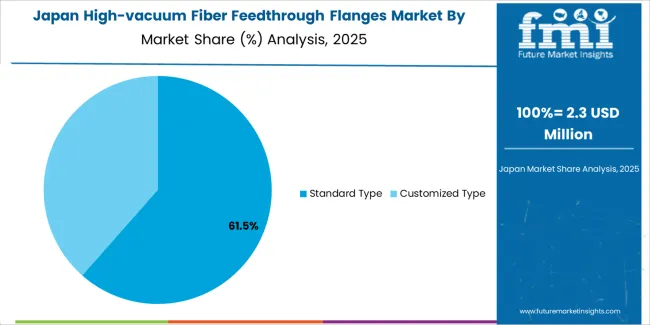
In Japan, the High-vacuum Fiber Feedthrough Flanges market prioritizes standard type systems, which capture the dominant share of semiconductor manufacturing and analytical instrumentation installations due to their proven features, including reliable vacuum optimization and seamless integration with existing instrumentation infrastructure. Japanese manufacturing operations emphasize reliability, precision, and long-term operational excellence, creating demand for standard type systems that provide consistent sealing capabilities and superior vacuum performance based on instrumentation requirements and quality standards. Customized type maintains secondary positions primarily in specialized aerospace applications and unique instrumentation installations where application-specific functionality meets operational requirements without compromising vacuum precision.
Market Characteristics:
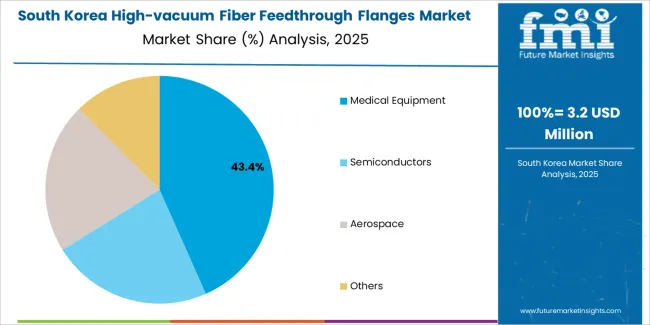
In South Korea, the market structure favors international component manufacturers, including Thorlabs, OEfind, and Hositrad, which maintain dominant positions through comprehensive product portfolios and established technology networks supporting both semiconductor manufacturing vacuum and medical equipment instrumentation installations. These providers offer integrated solutions combining advanced feedthrough flange systems with professional technical services and ongoing quality support that appeal to Korean manufacturers seeking reliable vacuum systems. Local technology distributors and service providers capture moderate market share by providing localized support capabilities and competitive pricing for standard vacuum installations, while domestic manufacturers focus on specialized applications and cost-effective solutions tailored to Korean technology market characteristics.
Channel Insights:

The High-vacuum Fiber Feedthrough Flanges market operates with moderate concentration, featuring approximately 10-12 meaningful participants, where leading companies control roughly 55-60% of the global market share through established technology relationships and comprehensive vacuum component portfolios. Competition emphasizes advanced sealing capabilities, vacuum integrity reliability, and instrumentation integration rather than price-based rivalry. The leading company, Thorlabs, commands approximately 28% market share through its extensive feedthrough flange product line and global precision instrumentation presence.
Market Leaders encompass Thorlabs, OEfind, and Hositrad, which maintain competitive advantages through extensive vacuum technology expertise, global semiconductor networks, and comprehensive instrumentation integration capabilities that create customer loyalty and support premium pricing. These companies leverage decades of precision engineering experience and ongoing innovation investments to develop advanced feedthrough systems with hermetic sealing control and reliability features. Technology Innovators include Engionic, Shanghai YiNGUAN Semiconductor Technology, and regional specialists, which compete through specialized vacuum technology focus and innovative sealing capabilities that appeal to manufacturers seeking advanced feedthrough solutions and operational optimization.
These companies differentiate through rapid product development cycles and specialized application focus. Regional Specialists feature component manufacturers focusing on specific geographic markets and specialized applications, including ultra-high vacuum systems and integrated instrumentation solutions. Market dynamics favor participants that combine reliable sealing performance with advanced vacuum capabilities, including precision hermetic design and automatic leak detection integration features. Competitive pressure intensifies as traditional vacuum equipment suppliers expand into fiber feedthrough systems, while specialized precision companies challenge established players through innovative sealing solutions and customized platforms targeting semiconductor manufacturing and medical instrumentation segments.
| Item | Value |
|---|---|
| Quantitative Units | USD 68.8 million |
| Product Type | Standard Type, Customized Type |
| Application | Medical Equipment, Semiconductors, Aerospace, Others |
| Regions Covered | Asia Pacific, Europe, North America, Latin America, Middle East & Africa |
| Countries Covered | China, India, Germany, Brazil, United States, United Kingdom, Japan, and 20+ additional countries |
| Key Companies Profiled | Thorlabs, OEfind, Hositrad, Engionic, Shanghai YiNGUAN Semiconductor Technology, Shenzhen Xinray Technology, SQS |
| Additional Attributes | Dollar sales by product type and application categories, regional adoption trends across Asia Pacific, Europe, and North America, competitive landscape with vacuum component manufacturers and instrumentation suppliers, manufacturer preferences for vacuum integrity and sealing reliability, integration with instrumentation platforms and quality monitoring systems, innovations in sealing materials and vacuum excellence, and development of automated leak detection solutions with enhanced performance and operational optimization capabilities. |
The global high-vacuum fiber feedthrough flanges market is estimated to be valued at USD 68.8 million in 2025.
The market size for the high-vacuum fiber feedthrough flanges market is projected to reach USD 106.8 million by 2035.
The high-vacuum fiber feedthrough flanges market is expected to grow at a 4.5% CAGR between 2025 and 2035.
The key product types in high-vacuum fiber feedthrough flanges market are standard type and customized type.
In terms of application, medical equipment segment to command 45.0% share in the high-vacuum fiber feedthrough flanges market in 2025.






Full Research Suite comprises of:
Market outlook & trends analysis
Interviews & case studies
Strategic recommendations
Vendor profiles & capabilities analysis
5-year forecasts
8 regions and 60+ country-level data splits
Market segment data splits
12 months of continuous data updates
DELIVERED AS:
PDF EXCEL ONLINE
Fiber to the Home Market Size and Share Forecast Outlook 2025 to 2035
Fiber Based Packaging Market Size and Share Forecast Outlook 2025 to 2035
Fiber Lid Market Forecast and Outlook 2025 to 2035
Fiberglass Tanks Market Size and Share Forecast Outlook 2025 to 2035
Fiber Sorter Market Size and Share Forecast Outlook 2025 to 2035
Fiber Reinforced Polymer Panel and Sheet Market Size and Share Forecast Outlook 2025 to 2035
Fiber Optic Tester Market Size and Share Forecast Outlook 2025 to 2035
Fiber Laser Market Size and Share Forecast Outlook 2025 to 2035
Fiberglass Market Size and Share Forecast Outlook 2025 to 2035
Fiber Spinning Equipment Market Size and Share Forecast Outlook 2025 to 2035
Fiber Reinforced Plastic (FRP) Panels & Sheets Market Size and Share Forecast Outlook 2025 to 2035
Fiberglass Fabric Market Size and Share Forecast Outlook 2025 to 2035
Fiber Optic Connectivity Market Size and Share Forecast Outlook 2025 to 2035
Fiber Optic Collimating Lens Market Size and Share Forecast Outlook 2025 to 2035
Fiberglass Duct Wrap Insulation Market Size and Share Forecast Outlook 2025 to 2035
Fiber-Based Blister Pack Market Analysis - Size and Share Forecast Outlook 2025 to 2035
Fiber Optics Testing Market Size and Share Forecast Outlook 2025 to 2035
Fiber Laser Coding System Market Size and Share Forecast Outlook 2025 to 2035
Fiber Optics Market Size and Share Forecast Outlook 2025 to 2035
Fiber Reinforced Polymer (FRP) Rebars Market Size and Share Forecast Outlook 2025 to 2035

Thank you!
You will receive an email from our Business Development Manager. Please be sure to check your SPAM/JUNK folder too.
Chat With
MaRIA